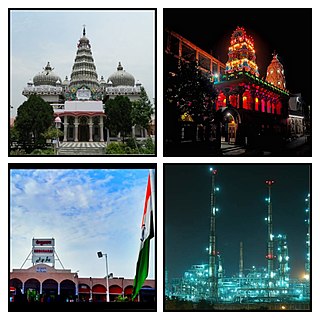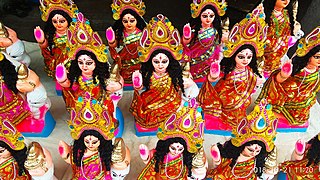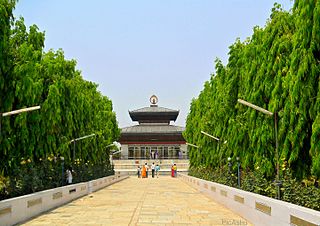
Vaisakha is a month of the Hindu calendar that corresponds to April/May in the Gregorian Calendar. In the Indian national calendar, Vaisakha is the second month of the year. It is the first month of the Vikram Samvat calendar, Odia calendar, Maithili Calendar, Punjabi calendar, Assamese calendar and the Bengali calendar. This month lies between the second half of April and the first half of May.

Goramansingh also known as Gauramansingh is a small village in the Darbhanga district of Bihar, India. It is located approximately 62 kilometers east of Darbhanga and 12 kilometers east from its subdivisional headquarters of Biraul on the bank of the Kamala River in Bihar.

Begusarai is the industrial and financial capital of Bihar and the administrative headquarters of the Begusarai district, which is one of the 38 districts of the Indian state of Bihar. The district lies on the northern bank of the river Ganges in the Mithila region of India.

Chhath is an ancient Hindu festival native to the Indian subcontinent, more specifically, the Indian states of Bihar, Uttar Pradesh, Jharkhand and the Nepalese Autonomous provinces of Koshi, Madhesh and Lumbini. Prayers during Chhath puja are dedicated to the solar deity, Lord Surya, to show gratitude for bestowing the bounties of life on earth and to request that certain wishes be granted.

Buddha's Birthday or Buddha Day is a primarily Buddhist festival that is celebrated in most of South, Southeast and East Asia, commemorating the birth of the prince Siddhartha Gautama, who became the Gautama Buddha and founded Buddhism. According to Buddhist tradition and archaeologists, Gautama Buddha, c. 563-483 BCE, was born at Lumbini in Nepal. Buddha's mother was Queen Maya Devi, who delivered the Buddha while undertaking a journey to her native home, and his father was King Śuddhodana. The Mayadevi Temple, its gardens, and an Ashoka Pillar dating from 249 BCE mark the Buddha's birth place at Lumbini.

Sharad Purnima is a religious festival celebrated on the full moon day of the Hindu lunar month of Ashvin, marking the end of the monsoon season. The full moon night is celebrated in different ways in various cultural regions across Indian subcontinent.

Kārtika is the eighth month of the Hindu calendar, which falls in October and November of the Gregorian calendar. In India's national civil calendar, Kartika is the seventh month of the year, beginning on 23 October and ending on 21 November.

Mithila, also known as Tirhut, Tirabhukti and Mithilanchal is a geographical and cultural region of the Indian subcontinent bounded by the Mahananda River in the east, the Ganges in the south, the Gandaki River in the west and by the foothills of the Himalayas in the north. It comprises certain parts of Bihar and Jharkhand of India and adjoining districts of the Koshi Province, Bagmati Pradesh and Madhesh Province of Nepal. The native language in Mithila is Maithili, and its speakers are referred to as Maithils.

Kartika Purnima, also known as Kartika Pournami, is a Hindu, Sikh, and Jain cultural festival that is celebrated on purnima, the 15th day of the lunar month Kartika. It falls on November or December of the Gregorian calendar and is also known as Tripurari Purnima or Deva-Deepavali, the gods's festival of lights. Karthika Deepam is a related festival that is celebrated in South India and Sri Lanka on a different date. It follows Diwali by about 15 days.

Duhabi is a Village Development Committee in Dhanusa District in the Janakpur Zone of south-eastern Nepal. At the time of the 1991 Nepal census it had a population of 5,762 persons residing in 990 individual households.
Mithila culture or Maithil culture refers to the culture which originated in the Mithila region of the Indian subcontinent. Mithila comprises Tirhut, Darbhanga, Kosi, Purnia, Munger, Bhagalpur and Santhal Pargana divisions of India and adjoining provinces of Province No. 1, Bagmati Pradesh, and Madhesh Province of Nepal.
Bihari culture refers to the culture of the Indian state of Bihar. Bihari culture includes Angika culture, Mithila culture, Bhojpuri Culture and the culture of Magadha.
Chainpur is one of the largest villages of Saharsa District in the Indian state of Bihar in North-East India, and is in the Kosi Division. In the revenue documents, it is mentioned as 'Chainpur Uttar Khand'. Chainpur has a number of tolas and occasionally called Pubari, Pachhwari, Uttarwari and Dakshinwari tola.

Gaura Parva is a Hindu festival celebrated by the people residing in Sudurpashchim province and parts of Karnali province of Nepal as well as in Kumaon region of Uttarakhand state of India. The festival commemorates the wedding of the goddess Gaura/Gauri (Parvati) to Shiva. The festival falls in the Hindu month of Bhadra (August/September).
Jur Sital or Maithil New Year is the celebration of the first day of the Maithil new year also called Aakhar Bochhor. Maithils eat Bori with Bhaat and Sondesh on the day. This day which usually falls on 14th or 15th April on Gregorian calendar is celebrated by the Maithils and Tharu people of India and Nepal. This is also called Nirayana Mesh Sankranti and Tirhuta new year. The festive occasion is in keeping with the Tirhuta Panchang calendar used in the Mithila region.
Tirhuta Panchang is a calendar followed by the Maithili community of India and Nepal. This calendar is one of the many Hindu calendars. It is a tropical solar Hindu calendar in which the year begins on the first day of Baishakh month i.e. Mesh Sankranti. Every year, this day falls on 13/14 April of the Gregorian Calendar

Simaria is a village in India, along the Ganges river. It is in Begusarai District, Mithila region of India and near Barauni. Also called Kumbhasthali, Amritbhumi, Welcome Gate of Mithila ,Known for the birthplace of Hindi poet Ramdhari Singh 'Dinkar', then part of Bengal Presidency, British India, now in Begusarai District, Mithila region of Bihar. Situated on the South Eastern boundary of Begusarai, It is also famous for Simaria Mela, a fair of devotional importance during the month of Kartik every year according to Indian Panchang. It has a famous bridge, the iconic Rajendra Setu providing both Rail and Road connectivity to this place. People of Simaria widely speak Maithili language.

Angika is an Eastern Indo-Aryan language spoken in some parts of the Indian states of Bihar and Jharkhand, as well as in parts of Nepal.

Jhijhiya (also called Jhijhari) is a cultural folk dance of Mithila and Bhojpuri region of India and Nepal. It is performed during the Dusshera festival, in the Hindu month of Ashwin (September/October). The dance is performed to offer devotion towards goddess Durga—the goddess of victory as well as to protect one's family, children and society from witches and dark magic.














